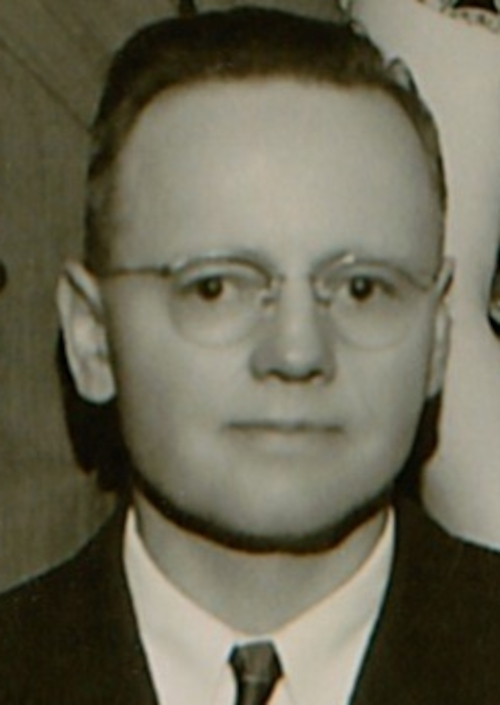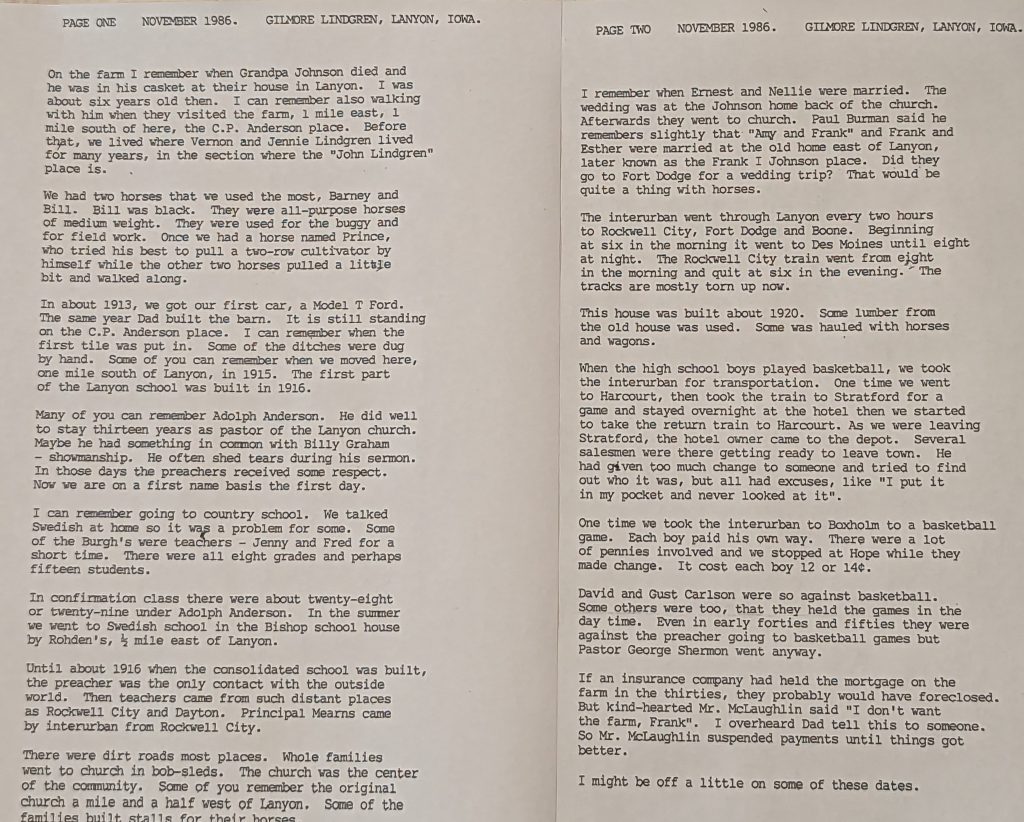
Gilmore Reuben Bernadotte Lindgren.
Born November 5, 1904, in Forest City, IA.
Died March 19th, 1993 (age 89).
Married: June 26, 1930 to Hazel Marie Hill (born November 27, 1907).
They were parents of four boys; Richard “Dick”, Theodore “Ted”, Carleton “Carl” and Jon. The four sons left Lanyon after high school and among them earned 2 medical degrees (MD), 2 doctorates (PhD) and a law degree.
Education: Iowa State College in agriculture and animal husbandry.
Occupation: Agriculture Teacher, Farmer.
Children
Richard Dan “Dick” Lindgren, MD. Dick married Ardeth Elaine Bradley and had four children; Laura Louise, Eric Daniel, Mark Richard, and Amy Beth. Dick and Ardeth lived in Madison WI, where Dick practiced radiology.
Theodore “Ted” Lindgren, PhD, JD, married Henrietta Elisabeth (“Bett”) Parnell. They had three children; Lisa, John and Anne. Ted and Bet lived in Houston as well as Georgia and Florida. Ted was on the faculty at Emory University and the University of South Florida where he established the Department of Electrical Engineering. He practiced patent law in Florida, New York and Texas.
Carleton Jay (“Carl”) Lindgren, MD. Carl married Alice Jane Ryan and had two children; Carla and Jay. Carl and Alice lived in Independence, MO where Carl practiced psychiatry.
Jon Gilmore Lindgren, PhD, married Elaine Wiederrecht and had two children; Ann and Ken. Jon and Elaine were both professors (Economics and Sociology, respectively) at North Dakota State University. Jon also served several terms as Mayor of Fargo, ND. Jon has a page on Wikipedia, which was developed a few years ago by his nephew Jay Lindgren.
I Remember Dad
Jon Lindgren, Gill’s youngest son, remembered that his father was unique among the farmers around their central Iowa area in that he was the only one with a college degree. His approach to management of the farm was based on science. He participated and provided leadership for the Farmers Organization. It was said that he was the only farmer who carried a fountain pen in his bib overalls and used it frequently to make notes for future reference. Jon commented that he was colloquially known as “Giley” among his friends and other farm owners in the surrounding area. Jon’s cousin Steve Lindgren, once commented that all of the Frank and Amy siblings seemed to be very even tempered and rarely raised their voices; Jon responded, recognizing that around a farm there was always important and timely work to be done, saying that; “Yes, but it was a little different when your Dad was also your boss.”
Amy Lindgren Gfesser and her husband Erik, located Gilmore’s recollections about life in Lanyon, his Johnson relatives and more. Below is a scan of the original document followed by Erik’s typescript of the document, which will be easier to read. Thank you Amy and Erik.

PAGE ONE NOVEMBER 1986. GILMORE LINDGREN, LANYON, IOWA.
On the farm I remember when Grandpa Johnson died and he was in his casket at their house in Lanyon. I was about six years old then. I can remember also walking with him when they visited the farm, 1 mile east, 1 mile south of here, the C.P. Anderson place. Before that, we lived where Vernon and Jennie Lindgren lived for many years, in the section where the “John Lindgren” place is.
We had two horses that we used the most, Barney and Bill. Bill was black. They were all-purpose horses of medium weight. They were used for the buggy and for field work. Once we had a horse named Prince, who tried his best to pull a two-row cultivator by himself while the other two horses pulled a little bit and walked along.
In about 1913, we got our first car, a Model T Ford. The same year Dad built the barn. It is still standing on the C.P. Anderson place. I can remember when the first tile was put in. Some of the ditches were dug by hand. Some of you can remember when we moved here, one mile south of Lanyon, in 1915. The first part of the Lanyon school was built in 1916.
Many of you can remember Adolph Anderson. He did well to stay thirteen years as pastor of the Lanyon church. Maybe he had something in common with Billy Graham – showmanship. He often shed tears during his sermon. In those days the preachers received some respect. Now we are on a first name basis the first day.
I can remember going to country school. We talked Swedish at home so it was a problem for some. Some of the Burgh’s were teachers – Jenny and Fred for a short time. There were all eight grades and perhaps fifteen students.
In confirmation class there were about twenty-eight or twenty-nine under Adolph Anderson. In the summer we went to Swedish school in the Bishop school house by Rohden’s, 1/2 mile east of Lanyon.
Until about 1916 when the consolidated school was built, the preacher was the only contact with the outside world. Then teachers came from such distant places as Rockwell City and Dayton. Principal Mearns came by interurban from Rockwell City.
There were dirt roads most places. Whole families went to church in bob-sleds. The church was the center of the community. Some of you remember the original church a mile and a half west of Lanyon. Some of the families built stalls for their horses.
PAGE TWO NOVEMBER 1986. GILMORE LINDGREN, LANYON, IOWA.
I remember when Ernest and Nellie were married. The wedding was at the Johnson home back of the church. Afterwards they went to church. Paul Burman said he remembers slightly that “Amy and Frank” and Frank and Esther were married at the old home east of Lanyon, later known as the Frank I Johnson place. Did they go to Fort Dodge for a wedding trip? That would be quite a thing with horses.
The interurban went through Lanyon every two hours to Rockwell City, Fort Dodge and Boone. Beginning at six in the morning it went to Des Moines until eight at night. The Rockwell City train went from eight in the morning and quit at six in the evening. The tracks are mostly torn up now.
This house was built about 1920. Some lumber from the old house was used. Some was hauled with horses and wagons.
When the high school boys played basketball, we took the interurban for transportation. One time we went to Harcourt, then took the train to Stratford for a game and stayed overnight at the hotel then we started to take the return train to Harcourt. As we were leaving Stratford, the hotel owner came to the depot. Several salesmen were there getting ready to leave town. He had given too much change to someone and tried to find out who it was, but all had excuses, like “I put it in my pocket and never looked at it”.
One time we took the interurban to Boxholm to a basketball game. Each boy paid his own way. There were a lot of pennies involved and we stopped at Hope while they made change. It cost each boy 12 or 14
¢.
David and Gust Carlson were so against basketball. Some others were too, that they held games in the day time. Even in early forties and fifties they were against the preacher going to basketball games but Pastor George Shermon went anyway.
If an insurance company had held the mortgage on the farm in the thirties, they probably would have foreclosed. But kind-hearted Mr. McLaughlin said “I don’t want the farm, Frank”. I overheard Dad tell this to someone. So Mr. McLaughlin suspended payments until things got better.
I might be off a little on some of these dates.
Other contributions are solicited …
I Remember Grandpa
Contributions are solicited …
I Remember Uncle Gil
Contributions are solicited …
